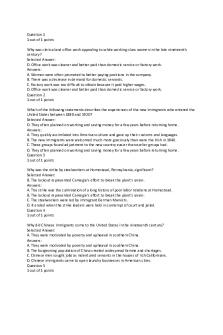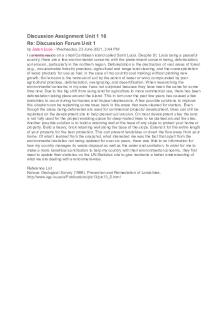Unit 1 Chapter 16 Quiz PDF

| Title | Unit 1 Chapter 16 Quiz |
|---|---|
| Course | Introduction to World History II (Middle Ages) |
| Institution | Park University |
| Pages | 3 |
| File Size | 38.1 KB |
| File Type | |
| Total Downloads | 95 |
| Total Views | 152 |
Summary
Unit 1 Chapter 16 Quiz...
Description
Question 1 1 out of 1 points The largest mass execution in American history took place as a result of Selected Answer: D. the Dakota uprising. Answers: A. an Indian uprising against the Dawes Severalty Act. B. the Battle of Bozeman Trail. C. Custer's last stand. D. the Dakota uprising. Question 2 1 out of 1 points Which Sioux leader led the forces that annihilated Colonel George A. Custer and his men on June 25, 1876? Selected Answer: B. Sitting Bull Answers: A. Chief Joseph B. Sitting Bull C. Red Cloud D. Geronimo Question 3 1 out of 1 points In the 1860s and 1870s, Nevada's Comstock Lode, Colorado's Rocky Mountains, and South Dakota's Black Hills were all known for Selected Answer: B. mining. Answers: A. cattle grazing. B. mining. C. sheep raising. D. frontier farming. Question 4 1 out of 1 points Which of the following phenomena led the U.S. government to dismantle the Indian reservation system it had previously established? Selected Answer: D. White land hunger Answers: A. Indian schools B. The Office of Indian Affairs C. Indian resistance D. White land hunger Question 5
1 out of 1 points White reformers, such as those who founded the Indian Rights Association, advocated for Selected Answer: D. the idea that Indians had the innate capacity to become equal with whites. Answers: A. the preservation of Indian culture. B. a reservation system as a means of saving Indian lives. C. a continuation of tribal authority. D. the idea that Indians had the innate capacity to become equal with whites. Question 6 1 out of 1 points Which Reconstruction-era politician created the blueprint for American economic expansion and later imperialism? Selected Answer: B. William Seward Answers: A. Edwin Stanton B. William Seward C. Thaddeus Stevens D. Ulysses Grant Question 7 1 out of 1 points Which of the following factors contributed to the failure of the Indian peace policy in the late nineteenth century? Selected Answer: B. Rivalries among different Christian missionary groups. Answers: A. The federal government's unwillingness to allocate funds B. Rivalries among different Christian missionary groups. C. The extermination of the bison D. Indians' desire to assimilate into white society Question 8 1 out of 1 points What distinguished farming on the plains in the 1880s from frontier farming in America fifty or one hundred years earlier? Selected Answer: D. Plains farmers raised cash crops that sold on the global market. Answers: A. Farmers on the plains received federal crop subsidies. B. Plains farmers used immigrant laborers rather than slaves. C. Farms on the plains focused on livestock rather than crops. D. Plains farmers raised cash crops that sold on the global market. Question 9 1 out of 1 points
Which Indian tribe was pursued 1,100 miles and forced to surrender just south of the Canadian border in 1877? Selected Answer: D. Nez Perce Answers: A. Cheyenne B. Sioux C. Dakota D. Nez Perce Question 10 1 out of 1 points During and after the Civil War, the Republican Congress implemented its economic vision for the United States by Selected Answer: C. subsidizing the transcontinental railroad. Answers: A. weakening the national banking system. B. lowering tariffs on foreign goods. C. subsidizing the transcontinental railroad. D. enacting a national minimum wage. Saturday, August 25, 2018 1:29:14 PM CDT...
Similar Free PDFs

Unit 1 Chapter 16 Quiz
- 3 Pages

Unit 1 Chapter 15 Quiz
- 3 Pages

Unit 1 Chapter 17 Quiz
- 3 Pages

QUIZ Chapter 16
- 16 Pages

Chapter 16 quiz
- 10 Pages

Unit 1 Quiz - Unit 1 quiz
- 5 Pages

Unit 1 QUIZ 1
- 3 Pages

Unit 1CSSelf-Quiz Unit 1
- 6 Pages

Self-Quiz Unit 1
- 8 Pages

Self-Quiz Unit 1
- 3 Pages

Discussion Assignment Unit 1 16
- 1 Pages

Unit 1 - Chapter 1
- 6 Pages

Chapter 1 - Unit 1
- 6 Pages

Chapter 1 Quiz 1
- 2 Pages

PSY 7709 Unit 1 Quiz - Quiz
- 19 Pages
Popular Institutions
- Tinajero National High School - Annex
- Politeknik Caltex Riau
- Yokohama City University
- SGT University
- University of Al-Qadisiyah
- Divine Word College of Vigan
- Techniek College Rotterdam
- Universidade de Santiago
- Universiti Teknologi MARA Cawangan Johor Kampus Pasir Gudang
- Poltekkes Kemenkes Yogyakarta
- Baguio City National High School
- Colegio san marcos
- preparatoria uno
- Centro de Bachillerato Tecnológico Industrial y de Servicios No. 107
- Dalian Maritime University
- Quang Trung Secondary School
- Colegio Tecnológico en Informática
- Corporación Regional de Educación Superior
- Grupo CEDVA
- Dar Al Uloom University
- Centro de Estudios Preuniversitarios de la Universidad Nacional de Ingeniería
- 上智大学
- Aakash International School, Nuna Majara
- San Felipe Neri Catholic School
- Kang Chiao International School - New Taipei City
- Misamis Occidental National High School
- Institución Educativa Escuela Normal Juan Ladrilleros
- Kolehiyo ng Pantukan
- Batanes State College
- Instituto Continental
- Sekolah Menengah Kejuruan Kesehatan Kaltara (Tarakan)
- Colegio de La Inmaculada Concepcion - Cebu
